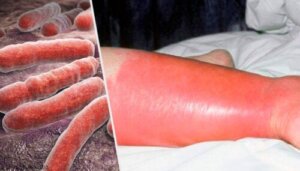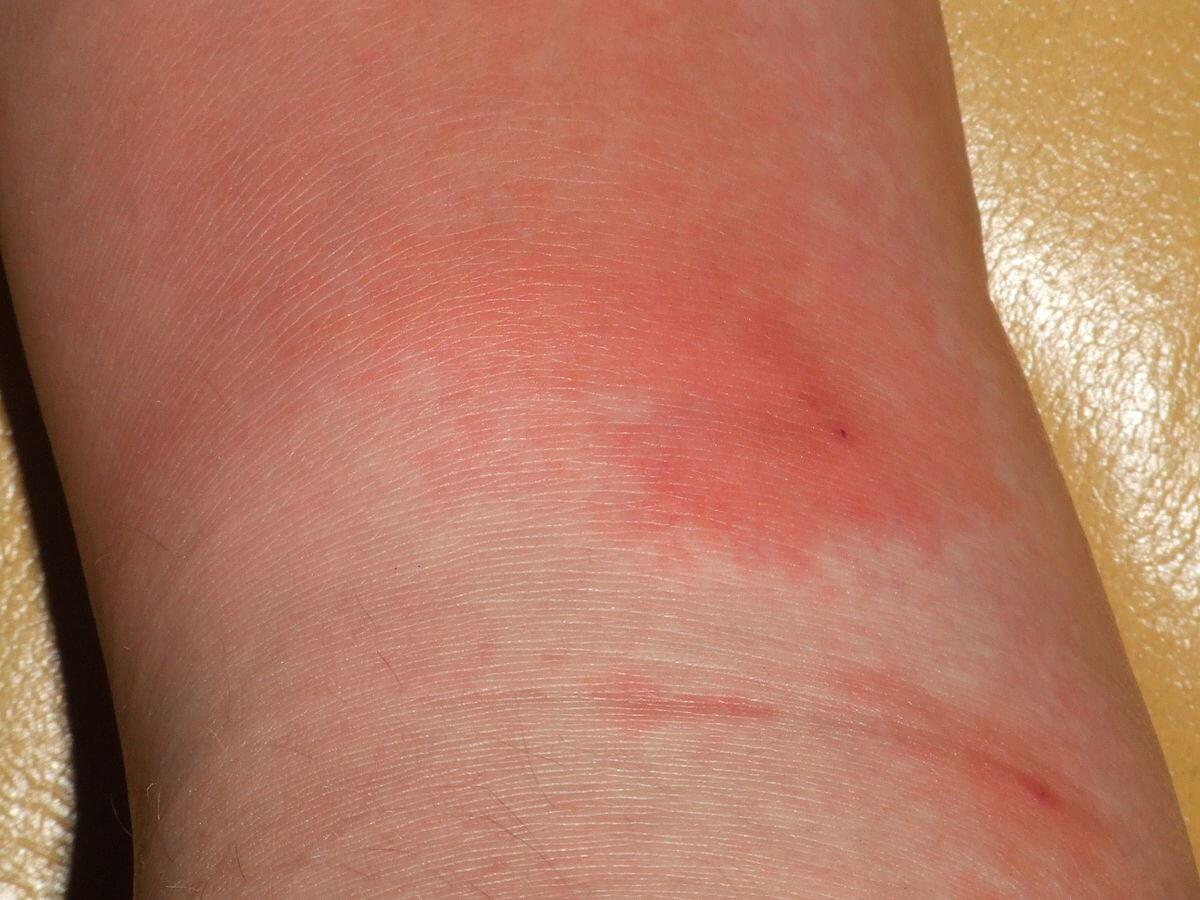Erysipelas in Children


Written and verified by the dermatologist Maria del Carmen Hernandez
Erysipelas in children is one of the major reasons for hospitalization and morbidity. It’s even a very common cause in pediatric primary care consultations. The origin of most cases of erysipelas is bacterial infectious conditions affecting the epidermis and superficial dermis.
The cause of erysipelas in children
Erysipelas is a skin infection affecting the epidermis and papillary dermis. However, it can spread to the lymph nodes of the superficial skin.
The majority of cases occurring on the face (5% to 20%) are due to group A beta-hemolytic Streptococcus, known as Streptococcus pyogenes. While the etiology of the lower extremities (80 % of cases) is related to other Streptococcus of group B, C, or G.

Skin fissures are the first step in the genesis of this disease. Therefore, there are multiple entry points for the bacteria to inoculate and proliferate:
- Surgical incisions
- Insect bites
- Small wounds
- Stasis ulcers
- Scratching lesions due to chickenpox
The infection spreads and directly invades the lymphatic system and causes the disease.
Clinical manifestations
When considering the diagnosis of erysipelas, the child should be examined for skin trauma or recent episodes of pharyngitis.
Local manifestations
Erysipelas in children is characterized by a region of reddened skin that is clearly defined and raised, according to a review published in The New England Journal of Medicine. It most often affects the lower extremities and then the face.
In most cases, it involves local signs such as the following:
- Pain
- Lymphangitis
- Regional adenopathy
In turn, children with erysipelas may complain of burning, tenderness, or itching in the area of infection.
General manifestations
General symptoms may vary according to severity. However, the most common signs are listed below:
- Fever
- Leukocytosis with neutrophilia
- Increased acute phase reactants (increased C-reactive protein)
One of the possible doors of entry may be the presence of a mycosis, so the interdigital spaces of the fingers should be examined for maceration, desquamation, or fissures.
The differential diagnosis is posed with infectious cellulitis. In fact, infectious cellulitis has poorly demarcated borders and its evolution is slower.
You may be interested in: Cellulitis in Children: What You Should Know
The complications of erysipelas
Erysipelas in children can develop a severe infectious picture, but it’s rarely fatal. Consequently, the most severe disease produces blisters, vesicles, and even obvious necrosis.
Some of the most relevant local complications include the following:
- Abscesses
- Scarlet fever
- Pneumonia
- Meningitis
- Cutaneous necrosis
- Hemorrhagic purpura
- Thrombophlebitis
- Blistering
Therapeutic options for erysipelas in children
When erysipelas is suspected, treatment with antibiotics against Streptococcus should be initiated.
Oral antibiotics
The first line of treatment for this disease is penicillin or its semi-synthetic derivatives, whose form of administration will depend on the severity of the clinical picture. This is recommended in the 2014 Guidelines for the Diagnosis and Management of Skin and Soft Tissue Infections of the American Society for Infectious Diseases.
In most cases, the duration of oral treatment is 5 days. However, when no improvement is seen, treatment may be extended for periods of 10 to 14 days.
Hospitalization
There may be times when the hospitalization of the patient is required for better care. The following are some of these situations:
- Necrotizing infection
- Signs of systemic toxicity or high fever
- Immunosuppressed patients
- Patients with poor adherence to medication and follow-up
- Failure of outpatient treatment

Other supportive measures
Supportive therapeutic options are cold compresses, hydration, paracetamol, or elevation of the lower extremities. Some studies have advised against the use of ibuprofen as a nonsteroidal anti-inflammatory drug because of its likely effect on increasing the frequency and severity of necrotizing fasciitis.
When gangrene or abscesses are present in children, surgical debridement is required. Consequently, infants, the immunosuppressed, and the elderly should be hospitalized.
Considerations for erysipelas in infancy
In most cases, erysipelas in infancy is a disease with a good prognosis and is usually treated on an outpatient basis. That is, it responds favorably to oral antibiotics.
The diagnosis is usually clinical, but if in doubt, the patient should be referred to a dermatologist. The specialist will be the one to indicate the treatment to be followed or the measures to be implemented. Therefore, under no circumstances should self-medication be used in this type of disease.
Erysipelas in children is one of the major reasons for hospitalization and morbidity. It’s even a very common cause in pediatric primary care consultations. The origin of most cases of erysipelas is bacterial infectious conditions affecting the epidermis and superficial dermis.
The cause of erysipelas in children
Erysipelas is a skin infection affecting the epidermis and papillary dermis. However, it can spread to the lymph nodes of the superficial skin.
The majority of cases occurring on the face (5% to 20%) are due to group A beta-hemolytic Streptococcus, known as Streptococcus pyogenes. While the etiology of the lower extremities (80 % of cases) is related to other Streptococcus of group B, C, or G.

Skin fissures are the first step in the genesis of this disease. Therefore, there are multiple entry points for the bacteria to inoculate and proliferate:
- Surgical incisions
- Insect bites
- Small wounds
- Stasis ulcers
- Scratching lesions due to chickenpox
The infection spreads and directly invades the lymphatic system and causes the disease.
Clinical manifestations
When considering the diagnosis of erysipelas, the child should be examined for skin trauma or recent episodes of pharyngitis.
Local manifestations
Erysipelas in children is characterized by a region of reddened skin that is clearly defined and raised, according to a review published in The New England Journal of Medicine. It most often affects the lower extremities and then the face.
In most cases, it involves local signs such as the following:
- Pain
- Lymphangitis
- Regional adenopathy
In turn, children with erysipelas may complain of burning, tenderness, or itching in the area of infection.
General manifestations
General symptoms may vary according to severity. However, the most common signs are listed below:
- Fever
- Leukocytosis with neutrophilia
- Increased acute phase reactants (increased C-reactive protein)
One of the possible doors of entry may be the presence of a mycosis, so the interdigital spaces of the fingers should be examined for maceration, desquamation, or fissures.
The differential diagnosis is posed with infectious cellulitis. In fact, infectious cellulitis has poorly demarcated borders and its evolution is slower.
You may be interested in: Cellulitis in Children: What You Should Know
The complications of erysipelas
Erysipelas in children can develop a severe infectious picture, but it’s rarely fatal. Consequently, the most severe disease produces blisters, vesicles, and even obvious necrosis.
Some of the most relevant local complications include the following:
- Abscesses
- Scarlet fever
- Pneumonia
- Meningitis
- Cutaneous necrosis
- Hemorrhagic purpura
- Thrombophlebitis
- Blistering
Therapeutic options for erysipelas in children
When erysipelas is suspected, treatment with antibiotics against Streptococcus should be initiated.
Oral antibiotics
The first line of treatment for this disease is penicillin or its semi-synthetic derivatives, whose form of administration will depend on the severity of the clinical picture. This is recommended in the 2014 Guidelines for the Diagnosis and Management of Skin and Soft Tissue Infections of the American Society for Infectious Diseases.
In most cases, the duration of oral treatment is 5 days. However, when no improvement is seen, treatment may be extended for periods of 10 to 14 days.
Hospitalization
There may be times when the hospitalization of the patient is required for better care. The following are some of these situations:
- Necrotizing infection
- Signs of systemic toxicity or high fever
- Immunosuppressed patients
- Patients with poor adherence to medication and follow-up
- Failure of outpatient treatment

Other supportive measures
Supportive therapeutic options are cold compresses, hydration, paracetamol, or elevation of the lower extremities. Some studies have advised against the use of ibuprofen as a nonsteroidal anti-inflammatory drug because of its likely effect on increasing the frequency and severity of necrotizing fasciitis.
When gangrene or abscesses are present in children, surgical debridement is required. Consequently, infants, the immunosuppressed, and the elderly should be hospitalized.
Considerations for erysipelas in infancy
In most cases, erysipelas in infancy is a disease with a good prognosis and is usually treated on an outpatient basis. That is, it responds favorably to oral antibiotics.
The diagnosis is usually clinical, but if in doubt, the patient should be referred to a dermatologist. The specialist will be the one to indicate the treatment to be followed or the measures to be implemented. Therefore, under no circumstances should self-medication be used in this type of disease.
All cited sources were thoroughly reviewed by our team to ensure their quality, reliability, currency, and validity. The bibliography of this article was considered reliable and of academic or scientific accuracy.
- Titou H, Ebongo C, Bouati E, Boui M. Risk factors associated with local complications of erysipelas: a retrospective study of 152 cases. Pan Afr Med J. 2017 Feb 5;26:66. doi: 10.11604/pamj.2017.26.66.11096. PMID: 28451043; PMCID: PMC5398858.
- Bisno AL, Stevens DL. Streptococcal infections of skin and soft tissues. N Engl J Med. 1996 Jan 25;334(4):240-5. doi: 10.1056/NEJM199601253340407. PMID: 8532002.
- Chartier C, Grosshans E. Erysipelas: an update. Int J Dermatol. 1996 Nov;35(11):779-81. doi: 10.1111/j.1365-4362.1996.tb02971.x. PMID: 8915727.
- Goettsch WG, Bouwes Bavinck JN, Herings RM. Burden of illness of bacterial cellulitis and erysipelas of the leg in the Netherlands. J Eur Acad Dermatol Venereol. 2006 Aug;20(7):834-9. doi: 10.1111/j.1468-3083.2006.01657.x. PMID: 16898907.
This text is provided for informational purposes only and does not replace consultation with a professional. If in doubt, consult your specialist.








